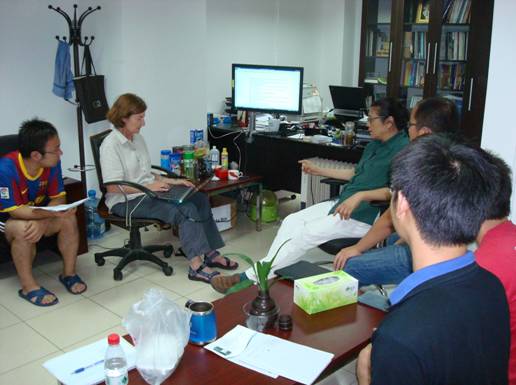Famous Anthropologists Dr. Cynthia M. Beall and Dr. Melvyn Goldstein Visited BIG
Dr. Cynthia M. Beall and Dr. Melvyn Goldstein, Professors of Case Western Reserve University and members of National Academy of Sciences, USA, a famous anthropologist couple, visited Beijing Institute of Genomics, Chinese Academy of Sciences (BIG, CAS) during August 11-16, 2011.
As a “Visiting Professor for Senior International Scientist of CAS”, Dr. Beall has been in collaboration with Dr. ZENG Changqing, Professor of BIG, in study of Tibetan adaptation to high-altitude hypoxia since 2006. During her visit, she discussed with group members of Prof. ZENG’s lab on data processing, tested oral epithelium cell sample DNA extraction and quality control. Dr. Beall and Prof. Zeng also drafted new plans on collaborative research.
Dr. Goldstein, Dr. Beall’s husband, is a social anthropologist specializing in social science of Tibetans and renowned internationally. His book “A History of Modern Tibet, 1913-1951: The Demise of the Lamaist State” became classic introduction to the field of Tibetan social science research.
Discussion with group members of Prof. Zeng’s lab (image by LIU Bo)
Dr. Beall and Dr. Goldstein gave two seminars to members of BIG on August 16. On behalf of the institute, Dr. YANG Weiping, Executive Vice Director of BIG, awarded certificate of “Visiting Professor for Senior International Scientist of CAS” to Dr. Beall. Prof. Zeng hosted the lectures.
Dr. YANG Weiping, Executive Vice Director of BIG, awarded certificate of “Visiting Professor for Senior International Scientist of CAS” to Dr. Beall (image by YU Xiaoqin)
In the lecture, Dr. Beall elaborated physical phenotypes of Tibetan adaptation to high-altitude hypoxia and compared their difference with Andean residents’ pattern of adaptation. Though they lived nearly at the same elevation, she said, Tibetans and Andeans utilized different ways to adapt to hypoxia. Dr. Goldstein showed great improvement in living conditions and life style of Tibetan nomads during the recent two decades by displaying materials and photos of social science documents.

